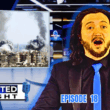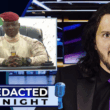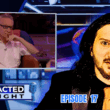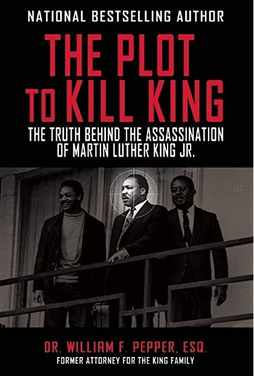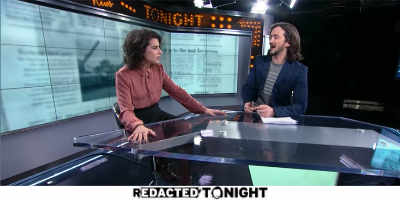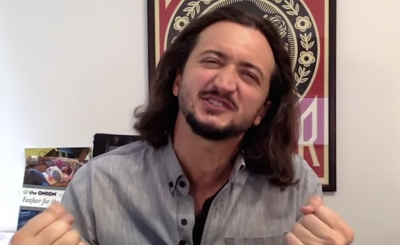Lee Camp interviews Dr. William Pepper, author of The Plot to Kill King: The Truth Behind the Assassination of Martin Luther King Jr.
TRANSCRIPT
Lee Camp (LC): Welcome to Redacted Tonight VIP. I’m Lee Camp, and this is a very special episode.
About five or six years ago, I was totally stunned to find out that the only trial ever held concerning the assassination of Martin Luther King Jr. was held in 1999, and I had never read about it. Never a mention!
After hearing from 70 witnesses, a jury found that a man named Loyd Jowers and unnamed co-conspirators, including government agencies, had killed Martin Luther King Jr. This trial was barely covered by the mainstream media. Well, today I have the lawyer of the King family who brought that trial, Dr. William Pepper, and in his new book, The Plot to Kill King, he named the man who he believes actually pulled the trigger and actually shot Martin Luther King Jr., conspiring with Loyd Jowers and others.
Today for the full half-hour: William Pepper. Dr. William Pepper, thank you so much for being here.
William Pepper (WP): Good to be with you.
LC: Much like the soda that shares your name, I think the truth you reveal is refreshing, and yet many people tell us not to consume it, so I think it’s appropriate. But I’ve read your book, The Plot to Kill King. It’s excellent and thank you for so many years of work. I’m going to try and go through this for people that are kind of uninitiated. Having followed this for 50 years now, can you go through it as well as you can? You put forward that James Earl Ray was not the killer. He was he was just a patsy, a fall guy. In this book for the first time, I think, at least in a book, you name who you believe is the actual shooter of Martin Luther King Jr., which we’ll get to in a moment, but first of all, I want to go back to just start with James Earl Ray’s confession. You knew him. You were his lawyer for some years. Why did he confess, and then why did he recant that confession?
WP: Well, James made the mistake of substituting Percy Foreman as his defense counsel for the Haynes father-son team. The Haynes father-and-son team were determined to have a trial for James because they knew there wasn’t enough evidence to convict him of the assassination. So Percy Foreman came on the scene and sort of forced his way into the case, and he promised James also that he would arrange for a trial. He was well known as an exemplary criminal defense lawyer. So James got conned into taking him. Now, after a period of time, Percy changed his tune, and he said he had come to the conclusion that the only way that Ray’s life could be saved was if he in fact agreed to accept a plea. James didn’t want to do that at all, but Percy said, “Look, they’re determined to get you,” but the critical point that he made was that his health was failing. He said, “My health is failing. I’m not going to be able to give you a good defense,” and that was a tip-off to James. And so what Percy then went on to say was, “Look, you cop to this plea, you take this plea, and I will arrange for $500 to go to your brother, and that $500 you can use to hire a new lawyer and you can reopen the case. And then you can go forward, but that is something that I think needs to be done on your behalf.”
LC: James Earl Ray stuck with that after he recanted. He stuck with the fact that he did not commit this murder for the rest of his life, despite offers of freedom and a lot of money, correct?
WP: Oh, there’s no question about it, and what happened was that James took the $500 from Percy and was preparing to reopen the case. And of course that never got anywhere. It got bogged down. I didn’t meet James until really ten years after the killing. I met him in August of ‘78 when Reverend Abernathy asked me to go and interrogate him because Abernathy was having some questions. So it took me a while to prepare. I thought they had the right guy, and I went up to the prison and we spent five hours with James, and I put him through a great deal of stressful interrogation. We came away from that meeting with a firm belief that he was not the shooter, but we didn’t know what knowing role he might have played. So that was ‘78. I kept visiting him and he raised enough issues that caused me to start going into Memphis and asking questions, and effectively start a private investigation. When I would visit him he kept asking me to represent him, and I said, “No, I can’t do that until I’m sure you were not a knowing participant.” That took 10 years. It was not until 1988 that I became convinced and I finally agreed to represent him.
LC: And Ray actually had an alibi that was kind of never brought forward, right? Two men, William Reid and Ray Hendrix, saw a man driving away from the area of the murder, before the murder took place, in a white Mustang that James Earl Ray owned. This corroborated Ray’s statement that he left the area to go fix a flat spare tire, but the state basically suppressed that evidence, right?
WP: That’s exactly right. We found it in the bottom of a file cabinet of documents on the case. It had just been buried. The statements that you mentioned had just been buried.
LC: Okay, so the official story, for people that don’t know, is that James Earl Ray, acting alone, shot King from the bathroom window of a boarding house that looked across to the Kings’ hotel room. That bathroom was above Jim’s Grill, which was owned by Loyd Jowers. And then Jowers in 1993 confessed, and he confessed on television, actually, on primetime live, to facilitating the assassination with people other than James Earl Ray. Talk about Jowers’ confession, and then talk some about the 1999 civil trial in which you represented Coretta Scott King and the King family.
WP: Loyd Jowers was in a very difficult position. He had been out in the bushes with the shooter and the shooter spotter, and he was the one who carried the rifle through the back door into his kitchen and he broke it down in front of his girlfriend, Betty Spates, who for years refused to make any statement about this. But she had actually seen Loyd running in, white as a ghost, perspiring and running by her breaking the rifle down. He said to her, “You would never do anything to hurt me, Betty, would you?” And of course she said, “No, of course not, Loyd,” and then she saw him break the rifle down and take it out in front. It was finally in 1992 that I was able to develop a relationship sufficient enough, after a number of years, that Betty Spates told me this whole story. So Jowers, yes, admitted that, and we had that information. We backed it up and we confronted him. And he was afraid that he was going to be indicted, so he didn’t know that the fix was very solidly put in. I had him make the statement before Dexter King and myself, and then he repeated it for Andrew Young and Dexter King. So Jowers put himself very much in the frame. Jowers was frightened, so he then decided to cooperate with us.
The 1999 trial happened the year after James died. James died in prison in 1998, and we had nowhere to go, so we thought, and then it occurred to me that because we had what we had on Jowers we could start a civil action. So we brought the civil action in Memphis, Tennessee.
The 1999 trial went on for 30 days with 70 witnesses and clearly laid out all of the evidence that we had at that point in time that had never been made available to the criminal court or an evidentiary hearing, and it was a powerful presentation with all those witnesses. The King family really thought that it brought closure for them.
LC: And it’s really kind of an amazing thing, at least in my personal experience, when I tell people about that civil trial, the only trial ever held about King’s murder, at first they’re totally shocked. Then they go and they do some of their own research, and one of the first things that comes up in the Google results for the trial is Snopes, which is known for refuting internet claims, and in the Snopes article they say oh, the civil trial was meaningless, and they claim that Jowers’ story changed too much and he was in it for the money. How do you know Jowers was speaking the truth?
WP: Well, I believe Jowers was speaking the truth because he told that same story consistently. He didn’t change his story, and once he decided to come forward, he told the story, and the story matched the evidence we had. We had Betty Spates who saw him bring the rifle in, break it down, and she said at a party she was very concerned about Jowers, and actually thought he was the shooter for a number of years. Up until the time that I dissuaded her of that, she thought Loyd was the shooter.
Then we had taxi driver McCraw who said Jowers showed him the rifle he had wrapped and broken down and was holding on a shelf under the counter in the grill. McCraw said he saw it and Jowers told him that this was the weapon that killed King, and someone was coming by to pick it up. And so we had other corroboration about what Jowers was saying that made us confident that he was telling the truth, and there was no reason for him not to tell the truth because we had the corroboration, and he was very afraid.
LC: Yeah, I mean you brought forward roughly 70 witnesses, I think, in that civil trial and you compare that to the only key state’s witness against James Earl Ray being one man, Charlie Stevens, who was blackout drunk at the time. So you compare that to 70 witnesses, and it’s kind of a preponderance of evidence.
WP: Yeah, I don’t think there is any question about that.
LC: So to get a little deeper into this: underneath the bathroom window, where they say James Earl Ray took the shot, was the back door to Jim’s Grill. And there were also bushes there, and then there was a wall that led to the parking lot to King’s hotel. Many witnesses over the years have said they saw a man jump down from that wall by the bushes where the shot was taken. You’ve got Solomon Jones. You got Earl Caldwell, Betty Spates, Loyd Jowers, Oliver Caitlyn and Louie Ward. All of them either saw a man jump down or they were up there in the bushes with him. And you now believe the man who jumped down was Earl Clark, a Memphis police officer who acted as the spotter during the assassination. How did you come to that conclusion?
WP: Well, for quite a period of time I thought Clark was the shooter. He was one of the best shooters, second best probably, to the actual shooter, on the Memphis police force. I thought it was Clark who was the shooter until I uncovered a witness, Lenny Curtis, who was a janitor at the rifle range, and he described to me the activity and the actions of the real shooter, a fellow named Frank Strausser, and what he did the entire day in terms of practicing with the rifle that had been specially brought for him—Lenny watched him practice hour after hour with that rifle, and then watched him take it away around three o’clock in the afternoon. But it was not only that. Strausser had engaged in very violent talk about King, that someone was going to blow is effing head off, and things of that sort.
Then after the killing, when feeling a little bit nervous about the fact that Lenny was in such a close position to everything that was going on at that rifle range, Strausser started intimidating him. And certainly whenever any story about the case came up, any documentary or any material came up, Strausser would make it a point of parking in an unmarked car outside of Lenny’s house. One time Lenny was lighting a cigarette entering the door and he smelled smoke, so he put it out. Someone had turned on the gas. There was a V in a tree overlooking his kitchen window. Strausser invited him to come along with him one day when he was going to pick up checks at the main police station. It was a very intimidating ride as Strausser pressed him on who he actually thought killed King, and did he think Ray was the killer. Of course, Lenny did the best he could to lie because he thought his life was in danger.
Well, I got that story and we deposed Lenny under oath. He told all the details. We filmed him, but I couldn’t use it for a number of years because I was afraid that while Lenny was alive, if we used that story, they would kill him, so I had to hold that back. And it was during that period of time I became convinced that it was not Earl Clark, who was a very close friend of Strausser’s—I don’t know about friend, but a colleague anyway, of Strausser’s—and I had to hold it back. But I turned my head toward the real shooter, and the person that went down over the wall was in fact captain Earl Clark who ran up the street and got into a waiting police car and was taken away.
LC: So you met with Strausser in 2013, and it’s truly incredible. I read the transcript, and it’s an incredible meeting because you asked him where he was during the assassination and he said at home. Then a moment later he said he was in his car and he heard it on the radio. Then he asked you what time of day the assassination took place. You said six o’clock, and he said, “AM or PM?” This all stunned me because this is the biggest incident to happen in Memphis history, and he was an officer at the time. All of a sudden, he doesn’t know when the assassination happened, whether it was morning or night, or where he was. This would be like a New York firefighter not knowing where he was or what time the towers fell.
WP: Yeah, I think he got bungled up there a bit, and of course what he didn’t know was I had arranged for another taxi driver, a colleague of his whom I’d known for 25 years—remember I was on that case for a very long time. I used to spend a lot of time on the streets, a lot of time in bars, and that’s how I got a lot of information. It was from just average people. And I arranged for this one taxi driver colleague who knew Strausser very well to jump in the back of his cab. It was Nathan Whitlock who jumped in the back of his cab and said, “Boy, I understand Pepper’s got enough to put you away, and that they’re going to charge you on this King case.” He just put that right out there following the interview session I had with him, and Strausser’s immediate response was, “What? Are they going to get me for something I did thirty years ago?” Then he stopped and said, “… or heard about.” So Nathan caught him in that sensitive, critical period of time.
LC: Yeah, it’s totally incredible, and then when you said someone else had identified him as the shooter, through the rest of the interview with you he never said “no,” or “what?” or “bullshit!” right? All he kept saying is, “I don’t know why he would say that,” so it struck me as just crazy that he would never say “that’s ridiculous.”
WP: Yeah, the thing I find most interesting about the meeting with Strausser was the size of his shoes because we had as evidence two plaster of Paris casts of the shoes that we believe were the cast of shoes of the shooter as he was going back away from the scene from the wall because it had rained heavily the night before. They were size 13, the cast of the shoes, and when I asked him the size of his shoes, he gave me a slight grin and said 13 large. He didn’t even think of denying that. He fit right in with the question.
LC: Right, and also, although it didn’t look good for him, he couldn’t help but brag about how he used to be an amazing shooter. He couldn’t help but brag there. So I want to back up for a minute and go to one other piece of the book that really shocked me. There’s a part where you bring up Daniel Ellsberg. For people that don’t know, he’s the man who leaked the Pentagon Papers in 1971, and most people view him as one of the most noble and trustworthy sources out there.
He signed an affidavit back in the 70s saying that he was told by Brady Tyson, an aide of the UN ambassador, Andrew Young, that they had said they were pretty sure they knew who killed King. It was FBI officers working under J. Edgar Hoover. Talk a little about Ellsberg, and also about how you think this is connected to Hoover.
WP: There’s no doubt that from the evidence that we’ve uncovered, and put forward in The Plot to Kill King, that Hoover was a very key player in the assassination of Martin Luther King, but he didn’t come in by himself. He sent Clyde Tolson in all the time. Tolson carried out all of Hoover’s wishes with respect to the Dixie Mafia, a group on the ground who were responsible for carrying out the operation of the assassination. Tolson would come in, and he would bring money, and he would bring instructions. He even went on two overseas trips, private trips with Russell Adkins, who was the godfather, if you will, of the Dixie Mafia group. And Russell Adkins’ son, Ron Tyler Adkins, as you know, if you read The Plot to Kill King, became a major witness for us because I deposed him over two days. Under oath, he just revealed so much information that was staggering, and of course it involved Tolson and money that came from Hoover.
What was most surprising to me was the fact that they broke James Earl Ray out of prison, that he had been profiled as an ideal patsy. Once that had been done in late 1967, Hoover sent in Tolson with twenty-five thousand dollars that Tolson gave to Adkins. Adkins, along with his son, went to the prison and gave it to the warden. The job was, of course, to allow James Earl Ray to escape—to fix his escape, which they did. James never knew this. He never knew that his escape was arranged, and that he was being set up at that earlier stage in ’67—I’m sorry, they brought money and set the thing up in ‘66, and James was allowed to escape in April of 1967. James didn’t know this, but the Hoover involvement was critical.
He, obviously, from what we learned, had used this Dixie Mafia family related to the large mafia organization of Carlos Marcello. They used them for a lot of local work that had to be done, and we didn’t get into that whole history, but we really focused on the extent to which they were useful in planning the assassination of Martin King.
LC: And speaking of setting James Earl Ray up, he insisted there was a man who he only knew as Raoul who kind of led him around for months, and he did jobs for him like gun-running, and he got Ray fake IDs. And your belief is that Raoul was setting Ray up to be the fall guy. Now the official story is that Raoul never existed. It was something Ray invented in his mind. Explain how you know that Raoul is a real person and who you believe it is.
WP: Well, Raoul Coelho was his name. Raoul Coelho has died, and he lived up on Alta Vista Avenue in Yonkers, New York. He was an immigrant from Portugal. In his history he had been involved with Portuguese intelligence and overseas operations in Angola and Africa, so he was a fairly sophisticated guy. He was brought in prior to the John Kennedy assassination.
Now we had five photographs of people we showed to people who had the capability of identifying Raoul. Raoul was in the spread of five. James never identified anyone as a photograph of Raoul, but this one he did. There’s no question about it, and when we sent an investigator to Raoul’s house, he knocked on the door and his daughter answered, and she was shown this photograph of her father. He said he’d been identified as a man who handled James Earl Ray and was a facilitator of the assassination of Martin Luther King. She was nonplussed and she said, “No, that couldn’t be, and anyway anyone could get that picture of my father. Anyone.” But she was effectively identifying the photograph as being that of her father.
Now along the road also a woman named Grabow came forward, and she was able to put a good deal of flesh on the bones with respect to Raoul and who he was and what he was involved in. So we had no question over a period of time that this man existed. Then we had a British merchant seaman who was approached by Raoul in Montreal in the same bar that James was in when he had escaped and he was trying to get out of the country. In that bar this fellow, this merchant seaman, remembered being approached by this this exact fellow. He identified the photograph and confirmed talking to him, so there was no question that he was there in the bar where James said he met him, near the docks of Montreal on West Commissioners Street [now renamed as Rue de la Commune] where he was trying to get travel papers and get out of North America.
LC: Right. You say you had multiple witnesses where you showed them the five or six photos of various people and they all said that’s Raoul. I want to switch for a second to the other special ops units that were on the rooves that day during the assassination. You found various witnesses to attest to that. Why were they up there if they weren’t the ones taking the shot?
WP: Well, they were up there to photograph everything and everyone who was in the area and there were two cameramen who were put up there by the captain of the fire station who also testified and gave his statement under oath. There was no question about it. They showed military credentials and they were put up there.
I believe that they were put up by John Downey who was head of the 902nd Military Intelligence Group. Downey coordinated a good deal of the backup military activity. It was Downey who chose the two military snipers, special ops guys who were at two different spots and were prepared to take out Martin King and, as it turned out, Andrew Young, who was a target as well. Downey wanted to get the complete photographic picture of everyone who was around there in case there was anyone who might have seen something he or she shouldn’t have seen. That’s my view of why they were there. They photographed the balcony. They photographed the whole parking lot area, and they photographed the bushes from where the shot came, and they photographed the shooter lowering the rifle.
Now one of my investigators, a former naval intelligence guy, was able to interview them, and it was made quite clear to him that the shooter they saw putting down the rifle was not James Earl Ray.
LC: Yeah, and the bushes you just mentioned were all chopped down and cleared away the following morning as if they’d never been there. Throughout your many years, many decades on this story, you’ve been attacked in the mainstream media, when they aren’t busy ignoring the story completely. Snopes claims that the mainstream media did cover the 1999 civil trial, but in fact they can only point to one New York Times article that was basically buried in The Times, so it really wasn’t covered, and throughout your research you’ve been attacked. You’ve been criticized. You state that at one point you were wearing a bulletproof vest in the courtroom. Talk a little about the hurdles you yourself have endured through these decades to get this story out.
WP: Well, it’s been a long effort, and it’s kind of like a slippery slope. I’m sure many investigative journalists and attorneys get involved in similar situations where you get into a case not thinking it’s going to hold you for very long or it’s going to have any degree of longevity. And then the more you learn, and the more you understand about what really happened and the injustice that took place—and particularly with effect to Martin King, you have to understand I was close to Martin only the last year of his life.
He asked to meet with me following my return from Vietnam where, as a journalist, I eventually published in Ramparts Magazine an article called “The Children of Vietnam” which showed the horrors of American war crimes in Vietnam. When Martin, who was a subscriber to Ramparts, saw that, he asked to meet with me and asked me to work with him, and we became close that last year of his life. I agreed to head the National Conference for New Politics at his request, which was to be an organization that was multi-faceted, multi-political, and multi-ideological, to build a third-party ticket against Lyndon Johnson. So I had that degree of a commitment and involvement with Martin King, and I couldn’t let go of it, so I went on and on. And yes, I don’t need to go into threats, that were numerous, and inconveniences.
I mean, I moved my first family to England in 1981 because my four-year-old son ended up picking up a telephone and hearing threats on his father’s life. I had people across the street in a duck blind and we lived on the water under surveillance. Up and down the beach I was followed continually. But when Shawn picked up the telephone, I heard the threat, and I said this is no way for a child to be raised, and no way for young children to live—and there were three—so I moved the family to Cambridge, England. I became a visiting scholar. They were raised in England, raised and educated in England, and then I would commute back and forth. So that first family suffered a lot in the sense of my absence being clearly heavy. And it also suffered because I put the funds that I would often earn from my legal practice… I became a barrister in England as well as an attorney in the United States, but I would often earn on commercial matters and I ended up slicing off funds onto this case. Over a period of 40 years, the amount of money that went out was well over a million dollars. Yeah, so those funds were taken away from my family.
LC: Yeah, and I just want to wrap up with this final question. You said you knew Martin Luther King Jr. for the final year of his life. After all these years, why do you think the powers that be found him so threatening? Why did he have to be stopped in such a horrible way?
WP: They couldn’t stop him any other way, and he had such a huge, sympathetic following across the country, a grassroots following. HL Hunt used to meet occasionally with Hoover, and he would tell Hoover that he could take care of King through broadcasting and demean him and all of that. Hoover said, “No, that’ll never work. He’s going to have to be taken out.” I know this because HL Hunt’s chief of staff turned over a lot of documentation and information to me.
It’s a very important historical fact to understand. In fact, this is a book I’m working on now, which is the history of political assassinations, so that Americans don’t think that what happened to us in the 60s in our republic in the 60s, is in some way unique. It’s important to understand that political assassinations have gone back as long as human society and human beings have lived together.
And what happens ordinarily is that if an individual who has a power base—and remember, the two roads to power are money and numbers—if an individual has a power base and a following and cannot be compromised, cannot be co-opted in some way, then the only road that’s left open very often for the ruling forces of a society to get rid of that person is assassination. That has been used throughout history.
The Plot to Kill King encompasses all of the statements under oath, all of the information—everything that was necessary to back up everything that we say about the assassination of Martin King, who was not, by the way—I’m sure you know if you read the book—was not killed by the shooter as he stood on the balcony but was instead assassinated in the emergency room of the hospital.
LC: Yeah, we didn’t even have time to get into that, but you go into great detail in the book about the fact that he was still alive when he arrived at the hospital, and it took the work, or lack thereof, of doctors to allow him to die.
WP: The doctor who took his life, who pulled out the catheters, chased everybody out of the emergency room, and put the pillow over his face and suffocated him—we have eyewitness testimony with respect to that, under oath—that doctor was the head of neurosurgery in the hospital and was also the family doctor for the Adkins Dixie Mafia family, and had said some weeks earlier in front of Russ Adkins’ son, “Just be sure you get him to St. Joseph’s Hospital. If he isn’t killed by the bullet, we will make sure he doesn’t leave alive.”
LC: Well, that’s truly, truly horrifying, but still, getting the truth out there is so important. Thank you, Dr. Bill Pepper.
